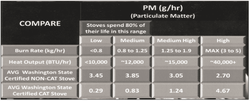Hi everybody,
I would bet my right arm that this is a topic that has been addressed more than once, but with my seaching abilities I haven't found those threads.
I am wondering whether creosote formation is something I should expect or worry about if I were to hypothetically burn 24/7 at the lowest rate at which my cat stove (Woodstock Fireview) will eventually consume all its fuel. For example, a full load burning 10 or 11 hours with the draft set between 1/2 and 3/4 (out of 4, that is). Assuming the combustor is functioning normally, I am under the impression that creosote formation will be mostly limited to the warming-up periods when the bypass door is open. Is this correct? And I do of course plan to have the chimney checked out and/or cleaned in the spring (I'll do that myself when I can't pay someone else to do it!).
Thanks,
Adam
I would bet my right arm that this is a topic that has been addressed more than once, but with my seaching abilities I haven't found those threads.
I am wondering whether creosote formation is something I should expect or worry about if I were to hypothetically burn 24/7 at the lowest rate at which my cat stove (Woodstock Fireview) will eventually consume all its fuel. For example, a full load burning 10 or 11 hours with the draft set between 1/2 and 3/4 (out of 4, that is). Assuming the combustor is functioning normally, I am under the impression that creosote formation will be mostly limited to the warming-up periods when the bypass door is open. Is this correct? And I do of course plan to have the chimney checked out and/or cleaned in the spring (I'll do that myself when I can't pay someone else to do it!).
Thanks,
Adam


